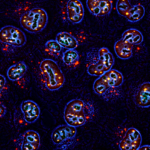Lien vers Pubmed [PMID] – 11244500
Oncogene 2001 Jan;20(1):1-9
Pax3 is an evolutionarily conserved transcription factor that plays a major role in a variety of developmental processes. Mutations in Pax3 lead to severe malformations as seen in human Waardenburg syndrome and in the Splotch mutant mice. The transcriptional activity of Pax3 was recently shown to be repressed by Daxx whereas the oncogenic fusion protein Pax3-FKHR is unresponsive to this repressive action. Here we demonstrate that Daxx-mediated repression of Pax3 can be inhibited by the nuclear body (NB)-associated protein PML. Interestingly, this suppression of Daxx properties correlates with its recruitment to the NBs. Factors such as arsenicals and interferons that enhance NB formation, trigger both the targeting of Daxx to these nuclear structures and the relief of the repressive activity of Daxx. Conversely, lack of structurally intact NBs profoundly impairs Pax3 transcriptional activity, likely by increasing the pool of available nucleoplasmic Daxx. Moreover, a PML mutant that can not be modified by the ubiquitin-related SUMO-1 modifier is no more able to interact with Daxx. Consistently, such a mutant fails both to inhibit the Daxx repressing effect on Pax3 and to induce its accumulation into the NBs. Taken together, these results argue that SUMO-1 modified PML can derepress Pax3 transcriptional activity through sequestration of the Daxx repressor into the NBs and suggest a role for these nuclear structures in the transcriptional control by Pax proteins. Oncogene (2001) 20, 1 – 9.

